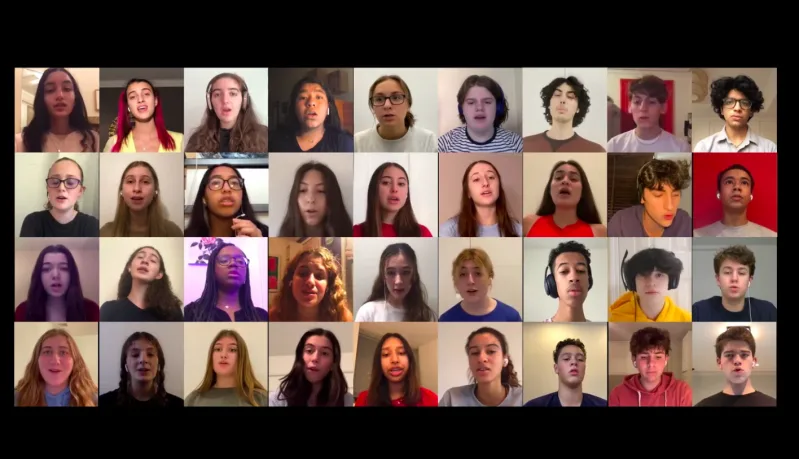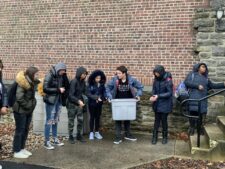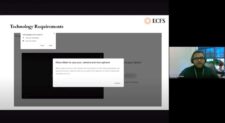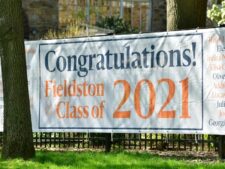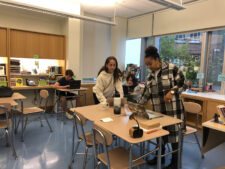As the Ethical Culture Fieldston School settled into a very different 2020–2021 academic year, one of the challenges posed to faculty and staff was how to maintain a vibrant and engaging performing arts program with students unable to gather in person for full rehearsals or performances. One option was to take their shows online: In the Theatre and Dance department, for example, Fieldston Upper and Middle students performed several innovative productions live over Google Meet this year.
But for the Music department, performing live — even remotely — was not an option due to the complexity of multiple people making noise on video services, which may not sync up within the tight rhythms necessary to play together.
This challenge did not silence the beating of drums and blowing of trumpets. Instead, the annual concerts for ECFS musicians moved online through full-scale, impressive video productions — edited to showcase the musicians perfectly in sync.
Before any performances got underway, the Music department took on the task of maintaining the hands-on, experiential learning that has always been a core tenet of progressive education at ECFS. This notion of learning-by-doing is central to the Music department, which features a predominantly practical curriculum — meaning an emphasis on actually playing instruments. With the exception of courses in music composition and electronic music, students typically gather together, pick up their instruments, and begin their learning.
Over the summer, as it became clear to the Music department that the School would be at least partially remote for much of the year, the faculty knew they needed to reassess how their program functions. Within the hyflex model — where students alternate between learning on campus and remotely — the challenge became how to teach students a body of work without full groups practicing together on campus.
The department introduced innovative digital tools, such as NoteFlight and SmartMusic, which allow students to learn and practice music remotely. The practice sessions are recorded and analyzed, and the programs provide real-time feedback for students, such as missed notes or incorrect rhythms. Tom Christensen, Chair of the Fieldston Upper and Middle Music department, sees these updates to the program as a bright spot in a challenging year.
“This digital fluency will stay there and we will use this to enhance the experience of the kids, as well as our teaching ability,” he says. “I will still have a performance-based jazz band, but I’m also going to use all this new software to make a stronger program when we’re back fully in person.”
Music is meant to be shared, to be heard and appreciated by others. Despite students not being able to perform together on campus — or live over Google Meet — the Music department faculty was still eager to share the joy and community created through music, and to showcase the hardwork and dedication of the students. To recreate this sense of community, each faculty member created video performances of their students, a complex and time-consuming process, but one that the students greatly appreciated.
“Students have told me they joined the music program for the camaraderie of playing with other students,” says Christensen. “The video performances are really important, because it gives them the feeling of doing that, even when they can’t all be together.”
Creating these video performances was no small feat, as it required the students to perform and record themselves multiple times before the Music faculty could edit the audio and video footage into one seamless performance. The process began with students recording themselves performing each song in multiple sections; by breaking up the score into sections, students didn’t need to feel pressure to play a full piece perfectly. To guarantee that the students all played at the same tempo, faculty members provided them with recordings with which to play along. After the students submitted their individual videos, each faculty member separated the audio and video, edited and mixed the audio files to ensure that everyone was at the same volume level, then replaced the full audio track over the video footage to complete the performance.
The faculty learned a range of lessons through the experience of creating these videos. While Christensen instructed his students to record each section of the score separately, he did not think to suggest they wear the same outfit each time they sat down to record, to create the illusion that the song was recorded in one sitting. One student even surprised him by getting a haircut in between takes. In the span of a few bars of music, the student transforms before the viewers’ eyes — a playful reminder of the unusual circumstances of this year’s concerts.
While most students recorded themselves from home, some of the smaller groups, such as the Fieldston Upper jazz combos and the percussion ensemble, were able to hold small, physically distanced performances on campus that were recorded and included in the videos. Before recording in the auditorium, the jazz students had about fifteen minutes to rehearse. As the musicians gathered, Christensen realized it was the first time they had played together all year. He looked around the room and felt the power of students coming together to create something beautiful. While the students and faculty were grateful to perform together in the impressive and innovative videos, they look forward to the day when they can return to creating music together in a shared space.
“We all took playing in person for granted,” says Christensen. “The first time I had kids in the room with me playing music was like a drink of cold water in the middle of the desert.”
This year’s performances — whether filmed separately and meticulously pieced together or in small groups of students who were just thrilled to stand six feet apart — were a reminder of the powerful ways in which our community finds ways to come together. Making music is a project we undertake in partnership with one another, and regardless of the circumstances, our students came together in harmony.
